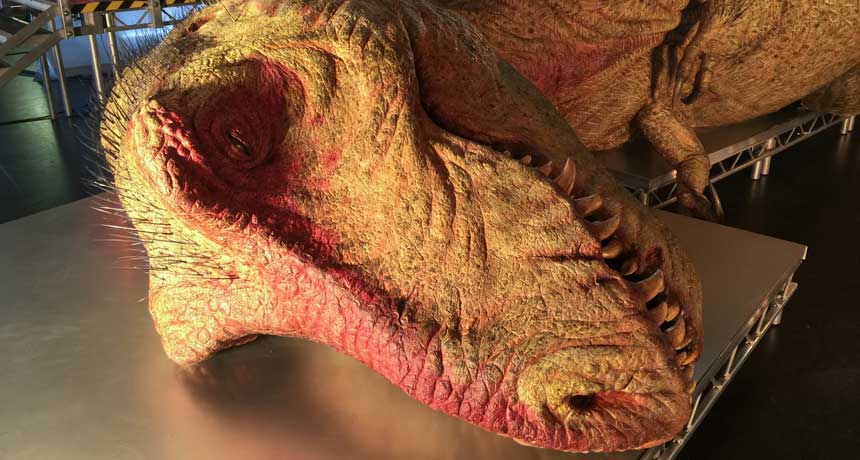A gory good time with a dinosaur dissection
T. rex Autopsy brings science to life with a full sized model

Life-like but not alive. Scientists dissected on camera this model of a Tyrannosaurus rex to teach viewers what we know about this dinosaur from its bones.
National Geographic Channels/Stuart Freedman
Most people think that scientists could never do a necropsy — death examination — on a dinosaur. After all, they went extinct millions of years before humans burst onto the scene.
And they are right. But with a little TV magic, scientists have faked it. The world’s first “T. rex Autopsy” will air on the National Geographic channel Sunday, June 7, at 9 p.m. ET. If you like dinosaurs, fun facts and buckets of fake blood, this is a show you will not want to miss.
Tyrannosaurus rexstalked what is now North America during the Cretaceous, more than 60 million years ago. So far, scientists have only turned up bones and fossilized feces of this scary predator. But even a few bones can provide many clues to what an animal looked like and how it would have behaved.
Based on these fossil hints, the Crawley Creatures workshop has built a stunning life-sized model of the dinosaur. Its bones, organs and even skin are based on what scientists currently think T. rex would have looked like.
Once the model was assembled, four scientists were set loose to “autopsy” the creature. (By the way, autopsy is the term for examining the cause of death in humans. So technically, the scientists on screen would have performed a necropsy — an examination of what caused an animal’s death.)
In this show, the scientists succeed in turning up how the animal “died.” The real point, however, was to teach us how a real T. rex might have lived.
As they work, the scientists drop lots of interesting tidbits. Dissecting a foot leads to an explanation about how the heavy giant managed to balance all of its weight on its toes. As they find out whether the dino was male or female, the scientists describe how birds (and dinosaurs) lay eggs. And as they yank out the megareptile’s huge sharp teeth, the scientists talk about the muscles that gave this hunter and scavenger its mighty bite.
The scientists involved with the show are well aware that a real dinosaur necropsy is impossible. Some creatures such as mammoths have been discovered frozen in ice. In theory, they could be necropsied. But the odds of finding a frozen T. rex?
“Never, ever, ever,” says John Hutchinson. He works at the Royal Veterinary College in London . There he studies evolutionary biomechanics — or how different types of movements have emerged in animals over time. He also offered advice to the team making the fake dinosaur.
You could never find a dinosaur frozen in ice and ready to be dissected, he says. “There’s no ice from that time period,” he explains. It might be possible to find one that has some of its soft features, such as skin or muscle, preserved. “But it won’t be bleeding,” he notes.
But this show has plenty of blood. The “autopsy” may be fake, but the show embraces the campy fun of what the real thing would be like. It supplies plenty of dino teeth, squishy sounding muscles and blood-spattering chainsaws to get through the animal’s larger limbs.
Hutchinson hopes the show will allow viewers to see how much we can learn about an animal from its fossils, even if we’ve never seen them in the flesh. “We can do this. We don’t need a time machine,” he says. “A lot of the science is possible without actually having been there.”
So if you’re up for a good, gory time, suspend your disbelief and have some fun. Along the way, learn a lot about T. rex.
“T. rex Autopsy” will air on the National Geographic Channel Sunday, June 7 and 9pm ET.
Follow Eureka! Lab on Twitter
Power Words
(for more about Power Words, click here)
biomechanics The study of how living things move, especially of the forces exerted by muscles and gravity on the skeletal structure.
Cretaceous Period A geologic time period that included the end of the Age of Dinosaurs. It ran from roughly 145.5 million years ago until 65.5 million years ago.
dissection The act of disassembling something to examine how it is put together. In biology, this means opening up animals or plants to view their anatomy.
evolution A process by which species undergo changes over time, usually through genetic variation and natural selection. These changes usually result in a new type of organism better suited for its environment than the earlier type. The newer type is not necessarily more “advanced,” just better adapted to the conditions in which it developed.
evolutionary An adjective that refers to changes that occur within a species over time as it adapts to its environment. Such evolutionary changes usually reflect genetic variation and natural selection, which leave a new type of organism better suited for its environment than its ancestors. The newer type is not necessarily more “advanced,” just better adapted to the conditions in which it developed.
extinct An adjective that describes a species for which there are no living members.
extinction The permanent loss of a species, family or larger group of organisms.
tyrannosaur A line of meat-eating dinosaurs that began during the late Jurassic Period, about 150 million years ago. These species persisted into the late Cretaceous Period, about 65 million years ago. The best known member of these species: the late Cretaceous’ Tyrannosaurus rex, a 12-meter (40 foot) long top predator of its time.
tyrannosaurid Any of the large, two-footed therapod tyrannosaurs living in the Cretaceous Period.
Tyrannosaurus rex A top-predator dinosaur that roamed Earth during the late Cretaceous period. Adults could be 12 meters (40 feet) long.